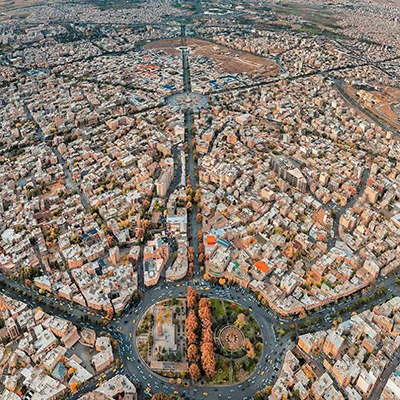Sites
Hamadan Province
Written by: Sajjad Naderipour,
Translated by: Hadi Qorbanyar
101 Views
In the eight years of the Iran–Iraq War, 8,000 martyrs, 27,000 veterans, and 1,000 prisoners of war were from Hamadan Province.
Covering an area of 19,493 square kilometers, Hamadan Province is located in western Iran. It borders Zanjan and Qazvin to the north, Lorestan to the south, Markazi to the east, and Kermanshah and part of Kurdistan to the west.[1] Hamadan’s climate varies due to its high mountains, numerous rivers and springs, and its diverse topography.[2]
The name “Hamadan” was first mentioned in cuneiform texts from ca. 1100 BC, the time of Assyrian King Tiglath-Pileser I, who called this place “Hamadana” or “Amadaneh”. In Achaemenid inscriptions, it was called “Hegmataneh”, while in the writings of the Greek historian Herodotus, it appeared as “Ecbatan”.[3]
At the time of the 2016 National Census, the province’s population was 1,738,234 people, of whom 1,097,217 lived in urban areas, 639,005 in rural settlements, and 2,012 were classified as non-resident (including nomads and the homeless). The province consists of the following counties: Hamadan, Famenin, Razan, Kabudarahang, Bahar, Asadabad, Malayer, Tuyserkan, and Nahavand.[4]
With the rise of the revolutionary movement against the Pahlavi regime in 1978–79, the people of Hamadan—under the leadership of Ayatollah Seyyed Asadollah Madani—played a decisive role in the victory of the Islamic Revolution. Among the most notable events was a week-long hunger strike by 2,800 air force personnel at Shahrokhi (now Shahid Nojeh) Air Base on January 21, 1979, followed by a protest march by their families inside the base that led to the arrest of 11 women.[5]
Immediately after the victory of the Revolution, on March 18–19, 1979, the Army forces from Hamadan Province, together with units of the 28th Kurdistan Division, resisted the siege of the Sanandaj garrison by anti-revolutionary elements and managed to hold the base.
In September 1979, the Hamadan Islamic Revolutionary Guard Corps (IRGC) was formed under the guidance of Ayatollah Madani, and its forces were deployed to Kurdistan to counter anti-revolutionaries. IRGC units from the province also took part in operations to liberate Marivan and Mahabad (August 17, 1979), the Qorveh–Dehgolan axis (May 1980), Bijar (August 1980), Baneh (May 27, 1980), Marivan (June 24, 1980), Saqqez (August 17, 1979), and Paveh (August 18–19, 1980).[6] On July 10, 1980, the IRGC forces from Hamadan played a key role in thwarting the American-backed coup attempt at Shahid Nojeh Air Base.
From the very first day of the Iran-Iraq War, the pilots of Shahid Nojeh Air Base took to the skies, striking enemy positions deep inside Iraq.
By securing the province’s airspace and through the timely response of air defense systems and fighter jets from Shahid Nojeh Air Base, these forces succeeded in downing 10 Iraqi aircraft over the course of one week.[7]
In 1981, a number of IRGC commanders stationed in western Iran were dispatched to the south to form a new brigade. Hussain Hamadani, one of the founders of the IRGC in Hamadan, together with Mahmoud Shahbazi, then commander of the IRGC in Hamadan, played an influential role in establishing this new unit, known as the 27th Muhammad Rasulullah (pbuh) Brigade.[8] In addition, Basij fighters from Hamadan Province served in units such as the Nabi Akram (pbuh) Brigade, the 3rd Special Martyrs Division, and the 43rd Imam Ali (as) Engineering Division of the IRGC.
In March 1983, with the formation of the 32nd Ansar al-Hussain (as) Brigade under the command of Hussein Hamadani (later martyred), the forces from this province participated in the war in a more organized way. Over the course of the Iran–Iraq War, IRGC and Basij forces from Hamadan took part in 30 offensive operations and more than 20 defensive ones.[9]
Shahid Ghahraman Brigade of the Army in Hamadan Province was also active in Kurdistan between 1979 and 1980. With the outbreak of the war, it participated in various operations, including several defensive ones in southern and southwestern Iran.[10]
The pilots of Shahid Nojeh Air Base also carried out a wide range of operations during the war. Among the most notable were the H3 airstrike against Iraq’s Al-Walid Air Base, which destroyed 50 percent of Iraq’s aircraft, and the daring air raid over Baghdad in which martyr Abbas Doran bombed the Al-Doura oil refinery.[11]
Hamadan Province itself was targeted 300 times by enemy air raids during the eight years of the war. 130 Iraqi strikes hit residential, commercial, and industrial areas, with over 2,000 rockets, bombs, and missiles dropped. For instance, the Friday Prayer Ceremony held at Qods Stadium, Hamadan, and Nahavand were attacked, resulting in the martyrdom of 786 civilians and the destruction of 16,000 residential, commercial, and industrial units. [12]
The Jahad-e Sazandegi Organization in Hamadan Province also played a vital role in providing engineering and logistical support during the war. The members of the organization participated in various operations and undertook major engineering projects, such as building a road over the Bazi Deraz Heights (Kermanshah) and constructing the Seyyed al-Shuhada (as) Bridge over the Choman River on the border with Iraq’s Sulaymaniyah Province.[13]
The War Support Headquarters was established in 1983. It was responsible for coordinating and organizing public contributions from Hamadan Province. This headquarters brought together the Army, the IRGC, Jahad-e Sazandegi, the provincial government, the Imam Khomeini Relief Committee, the Welfare Organization, and the office of the Friday Prayer leader. It oversaw the provision of assistance to the warfronts until 1988. Public contributions from Hamadan included 10 billion rials in cash, 10,000 truckloads of supplies, and about 10 kilograms of gold and jewelry. Two large field kitchens were also established in Gilan-e Gharb, Dezful, and Ahvaz, providing meals for about 70,000 people daily. Other measures organized by the Hamadan War Support Headquarters included constructing and reconstructing 5,000 residential, administrative, commercial, and industrial units in the outskirts of Sarpol-e Zahab, as well as donating 80,000 units of blood for those injured in the war.[14]
During the eight-year Iran–Iraq War, more than 80,000 volunteers from Hamadan Province served in the Basij and the IRGC, and over 20,000 participated in Jahad-e Sazandegi Organization, the Red Crescent, and the War Support Headquarters (government-affiliated) activities. 8,000 martyrs, 16,000 wounded veterans, and 970 prisoners of war were from Hamadan.[15]
Prominent martyrs from Hamadan include Haj Muhammad Talebian, Ayatollah Muhammad-Ali Heydari, Ali Chitsazian, Taqi Bahmani, Muhammad-Reza Farahani, Haj Sattar Ebrahimi, Hassan Tajouk, Mohsen Ein-Ali, Ebrahim-Ali Masoumi, Hussain-Ali Nouri, Younes Ganji, Ali-Reza Hajibabaei, Haj Reza Shokri-Pour, Rasoul Heydari, and Mosayeb Majidi.[16] The most notable martyr of the province is Commander Hussain Hamadani, who was one of the founders of the IRGC in Hamadan, the first commander of the 32nd Ansar al-Hussain (as) Brigade, commander of the 16th Qods Division in Gilan, commander of the 27th Muhammad Rasulullah (pbuh) Brigade, deputy commander of the Tharallah (as) Headquarters of the IRGC, deputy commander of the Basij, and senior commander of Iranian military forces in Syria against ISIS terrorists. He was martyred in October 2015 while on an advisory mission near Aleppo in an ISIS ambush.[17]
Books focused on the martyrs of Hamadan Province include Dokhtar-e Shina (Shina’s Daughter), Golestan-e Yazdahom (11th Golestan), and Ab Hargez Nemimirad (The Water will Never Die), all of which have received official endorsements from the Supreme Leader of Iran.
The Hamadan Sacred Defense Garden Museum was inaugurated in 2010 in the Abbasabad Hill area.[18]
[1] Akbari, Manouchehr, Vasiyatname-ye Kamel-e Shuhada-ye Ostan-e Hamadan, Vol. 1 (Complete Will of Martyrs of Hamadan Province, Vol. 1), Tehran, Entesharat-e Shahed, 1395, p. 25.
[2] Ibid.
[3] Ibid.
[4] Markaz-e Amar-e Iran, Natayej-e Tafsili-ye Sarshumari-ye Omumi-ye Nofus va Maskan 1395 (Detailed Results of the 2016 National Census), Tehran, 1397, p. 90.
[5] Sayt-e Markaz-e Asnad-e Enqelab-e Eslami (Islamic Revolution Documents Center Website), Code: 5581.
[6] Akbari, Manouchehr, Ibid., p. 28.
[7] Ibid.
[8] Sayt-e Markaz-e Asnad-e Enqelab-e Eslami (Islamic Revolution Documents Center Website), 14/7/1400, Code: 7207.
[9] Akbari, Manouchehr, Ibid., Pp. 28-29.
[10] Ibid., p. 29.
[11] Ibid.
[12] Khabargozari-ye Jomhouri-ye Eslami (Jomhouri-ye Eslami News Agency; https://irna.ir/x3mSQq; Khabargozari-ye Seda va Sima (IRIB News Agency), https://www.iribnews.ir/00DXdW
[13] Akbari, Manouchehr, Ibid., Pp. 29-30.
[14] Khabargozari-ye ISNA (ISNA News Agency), Code: 8607-03769/14/, Mehr 1386.
[15] Akbari, Manouchehr, Ibid., p. 30.
[16] Ibid.
[17] Sayt-e Markaz-e Asnad-e Enqelab-e Eslami, Gozari bar Hayat-e Siasi va Ejtemai-ye Sardar-e Shahid Haj Hussain Hamadani (Islamic Revolution Documents Center Website: Overview of the Political and Social Life of Martyr Haj Hussain Hamadani), Code: 5231.
[18] Khabargozari-ye Tasnim (Tasnim News Agency), https://tn.ai/1360616





